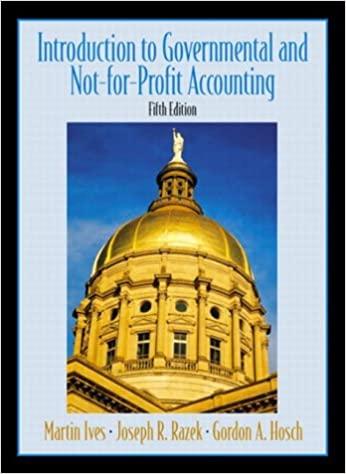. (Multiple-choice) : 1. What is a key difference between budgets prepared by governmental units and by...
Question:
. (Multiple-choice) :
1. What is a key difference between budgets prepared by governmental units and by commercial organizations?
a. Budgets prepared by commercial organizations must be approved by a governing body, whereas those prepared by governmental units need no approvals.
b. Budgets prepared by governmental units are legal documents, whereas those prepared by commercial organizations are not.
c. Operating, capital, and cash budgets are prepared by governmental units, but only operating budgets are prepared by commercial organizations.
d. Budgets prepared by commercial organizations are formally recorded in the organizations’ operating accounts, whereas those prepared by governmental units are not.
2. Which of the following is not included in a cash budget?
a. Personal services
b. Redemption of bonds
c. Utilities
d. Depreciation 3. Who prepares a nondepartmental expenditures request?
a. The department heads as a group
b. The auditor
c. The city council
d. The CEO or the budget director 4. Which of the following is an objection to the object-of-expenditure approach to budgeting?
a. Budgets prepared under this approach are complicated and difficult to prepare.
b. Information presented in this type of budget is difficult to incorporate into the accounting system.
c. Legislative bodies are given more detail than they can handle; therefore, they tend to focus on individual items rather than on the overall goals and programs of the organization.
d. Detailed comparisons between budgeted and actual revenues and expenditures are difficult to make.
5. What tool is commonly used to project certain types of revenues?
a. Trend analysis Der ERT
c. Queuing theory
d. Cost-volume—profit analysis 6. Which of the following is not a basic rule to follow when using budgets?
a. The budget must be presented in a positive manner.
b. The budget must have the support of top management.
c. Managers must only be held responsible for revenues and costs over which they have a degree of control.
d. The budget'must be prepared by top management.
ao ae 7. Acontinuous budget
a. Is used only by commercial organizations.
b. Covers a specific period but is continuously updated.
c. Is also known as a line-item budget.
d. Is valid over a range of activity, rather than just one level.
8. What approach to budgeting is most commonly used by governmental units?
a. Zero-based budgeting approach
b. Planning-programming—budgeting approach
c. Flexible budgeting approach
d. Object-of-expenditure approach
Step by Step Answer:

Introduction To Government And Not For Profit Accounting
ISBN: 9780130464149
5th Edition
Authors: Martin Ives, Joseph R. Razek, Gordon A. Hosch





